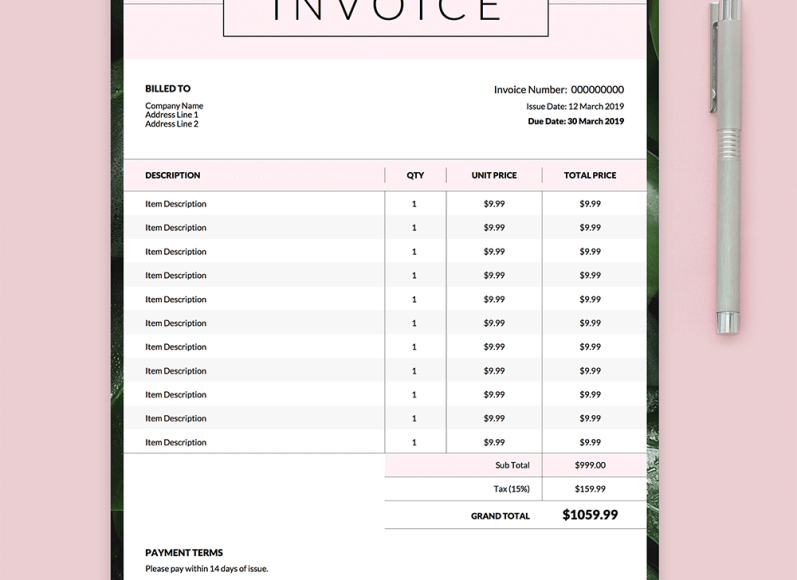What Is a Freelance Invoice?
A freelance invoice is more than just a document—it’s your professional handshake in the financial world. It’s an itemized bill sent to clients to request payment for services rendered. Typically, a freelance invoice includes details like the scope of work, hours billed, payment terms, and due dates.
In its simplest form, a freelance invoice acts as a formal record of the transaction between you and your client. It’s your proof of work and the client’s acknowledgment of their obligation to pay. Whether it’s a one-off project or recurring services, an invoice ensures clarity and sets expectations on both sides.
Who Gets It and When It Counts
Timing is everything. Freelance invoices are usually sent once the project is completed or at specific milestones, depending on the agreed-upon payment terms. For long-term contracts, many freelancers issue invoices monthly or bi-weekly.
But who are these invoices for? Essentially, anyone you work for as a freelancer:
- Direct clients: These can be businesses, startups, or individuals hiring you for your expertise.
- Agencies or intermediaries: If you’re working through platforms like Upwork or Fiverr, your invoice may need to meet their specific guidelines.
- Collaborative partnerships: Even if you’re subcontracting for another freelancer or agency, an invoice formalizes the arrangement and ensures timely payment.
Why Every Freelancer’s Success Hinges on It
Freelancing means wearing multiple hats, and that includes managing finances. Here’s why a freelance invoice is indispensable for every self-employed individual:
1. Professionalism
An invoice is your chance to showcase your brand. A clean, well-designed freelance invoice template with your logo, contact information, and payment details communicates that you take your business seriously.
2. Clarity in Payment Terms
Freelancers often face payment delays, and unclear terms can be a significant factor. A detailed invoice leaves no room for confusion about payment amounts, deadlines, and methods. It’s your safety net against misunderstandings.
3. Financial Record-Keeping
Keeping track of your earnings is crucial for managing cash flow and filing taxes. Freelance invoices provide a clear paper trail that helps during tax season and ensures you’re prepared for audits or financial reviews.
4. Legal Protection
In the unfortunate case of non-payment, a well-crafted invoice serves as legal evidence to enforce your claims. It shows that the client agreed to the terms and received your services.
What Every Freelance Invoice Must Hold to Seal the Deal
Creating a professional freelance invoice doesn’t need to be complicated. Here are the essential key components to highlight in your template:
- Header and Contact Information
Start with your brand identity, logo, and contact details. Below that, add your client’s name, company, and address.
- Invoice Number and Date
Assign a unique tracking ID to each invoice for effortless organization. Don’t forget to include the date when the invoice was issued.
- Project Description
Briefly describe the services provided. Break down the tasks or hours worked if applicable.
- Payment Details
Specify the total payable amount, payment methods (bank transfer, PayPal, etc.), and currency. Be precise to avoid confusion.
- Payment Terms
Specify the due date, late fees, and any discounts for early payment.
- Notes Section
Use this space for a personalized thank-you message or additional instructions.
Making It Yours: A Guide to Customizing Your Invoice Template
A generic invoice might do the job, but customizing it to suit your needs can elevate your professionalism.
Here are some tips to make your freelance invoice template stand out:
- Add Branding: Include your logo, use your brand colors, and choose a font that reflects your style.
- Automate: Use invoicing tools like Wave, Zintego, Vanazo to generate templates and send automated reminders for overdue payments.
- Adjust for Tax Requirements: Depending on your location, include applicable tax details like VAT or GST numbers.
- Language and Currency Options: If you work with international clients, customize the invoice for their local preferences.
Pitfalls to Dodge on Your Freelance Invoice Journey
Freelancers often make these mistakes that can delay payments or create friction with clients. Steer clear of these pitfalls:
- Omitting Essential Details: Missing the due date or payment instructions can confuse clients.
- Sending Late Invoices: Timely invoices are more likely to be paid on time.
- Using Unprofessional Formats: Avoid handwritten or overly casual invoices. Stick to clean, digital templates.
Why a Template is Your Freelance Billing Secret Weapon
If creating an invoice from scratch feels daunting, a freelance invoice template simplifies the process. Pre-designed templates save time and ensure consistency across all your client interactions. Additionally, they:
- Reduce Errors: Pre-filled fields reduce the risk of forgetting critical information.
- Enhance Organization: Templates make it easy to keep records and maintain a professional image.
- Support Scalability: As your business grows, a consistent invoicing system supports high client volumes.
Final Thoughts: Your Invoices, Your Voice
A freelance invoice is more than just a request for payment—it’s a reflection of your professionalism and attention to detail. With a solid template in place, you can focus less on chasing payments and more on doing what you love. By understanding the importance of timing, customization, and communication, you can transform invoicing from a mundane task into an opportunity to strengthen client relationships.
So, whether you’re just starting your freelance journey or are a seasoned professional, investing time in creating a robust freelance invoice template is a step toward building a thriving, sustainable business. Let your invoices speak volumes about your work ethic and leave your clients impressed long after the project ends.



